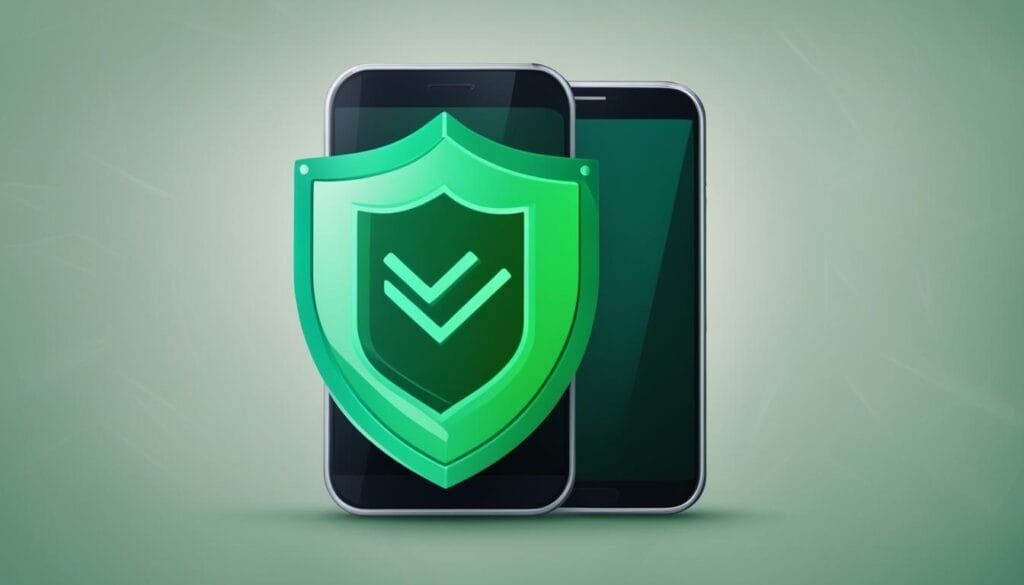With the increasing use of mobile apps for financial transactions, it’s crucial to understand how to protect your financial data and maintain your privacy. The risk of data breaches and cybercrime is on the rise, making it essential to safeguard your sensitive information. In this section, we will explore the best practices for protecting your financial data on mobile devices, including understanding the risks, reviewing privacy settings, and implementing effective security measures.
Key Takeaways:
- Financial privacy is paramount when using mobile devices for transactions.
- Understanding the risks involved and implementing security measures are vital.
- Reviewing and adjusting privacy settings can enhance your data protection.
- Encryption, masking, and tokenization techniques can further secure your financial data.
- Regularly updating security measures is crucial to stay ahead of cybercriminals.
The Risks of App Usage and Data Tracking
When you use mobile apps, particularly those related to social media, messaging, shopping, and personal finance, you may unknowingly expose your personal and financial information. Research shows that many apps collect a wide range of data points, including contact information, browsing history, location, and purchases. This data can be used for targeted advertising, but it also poses privacy risks. It’s important to understand which apps collect the most data and review their privacy details before downloading.
| Data Privacy | |
| Most Data-Hungry Apps | – Social Media |
| – Messaging | |
| – Shopping | |
| – Personal Finance |
By reviewing privacy settings and being proactive in understanding the information collected by apps, you can take steps to protect your personal information. Additionally, it’s essential to be wary of granting unnecessary permissions and to regularly check for app updates. Being mindful of the risks associated with app usage and data tracking can help you make informed decisions about which apps to trust with your personal information and financial data. Stay informed and stay protected.
Safeguarding Your Financial Data on Mobile
Protecting your financial data on mobile devices is of utmost importance in today’s digital landscape. With the increasing risk of data breaches and cybercrimes, it’s essential to implement robust security measures and utilize privacy settings to ensure the confidentiality and integrity of your sensitive information.
Securing Your Mobile Devices
To start, it’s crucial to keep your operating systems and apps updated. Regular updates often contain security patches that address vulnerabilities and protect against potential threats. Additionally, using strong passwords and enabling two-factor authentication adds an extra layer of security to your mobile devices.
When accessing your financial data on mobile, it’s important to be cautious while using public Wi-Fi networks. Public networks can be vulnerable to hackers, making it easier for them to intercept your data. Instead, consider using a Virtual Private Network (VPN) to encrypt your internet connection and safeguard your financial transactions.
Review and Adjust Privacy Settings
Reviewing and adjusting your app and social media privacy settings is another crucial step in protecting your financial data. Many apps and social media platforms collect and share extensive amounts of personal information, including your financial details. By carefully reviewing and adjusting these settings, you can have more control over what data is collected and shared.
Furthermore, consider limiting the amount of personal and financial information you share on social media platforms. Avoid posting specific details about your financial situation or transactions, as this information can be used by cybercriminals to target you.
Secure Mobile Transactions
When making financial transactions on mobile, ensure that you are using secure and trusted platforms. Look for the padlock symbol or “https” in the URL, indicating a secure connection. Avoid conducting financial transactions on unsecured or suspicious websites or apps.
Additionally, be cautious of phishing attempts and never provide your personal or financial information in response to unsolicited communication. Legitimate organizations will never ask for sensitive information via email, text message, or phone calls.
Summary
Protecting your financial data on mobile devices requires a proactive approach. By implementing security measures such as keeping your devices updated, using strong passwords, and being cautious on public Wi-Fi networks, you can reduce the risk of data breaches and unauthorized access. Reviewing and adjusting privacy settings, as well as conducting secure mobile transactions, further enhance the safeguarding of your financial data. Stay vigilant and prioritize the security of your financial information to maintain your privacy and protect your assets.

How Encryption, Masking, and Tokenization Can Enhance Financial Privacy
In today’s digital age, protecting your financial data is of utmost importance. One way to enhance the security of your financial information is through the use of encryption, masking, and tokenization techniques. These methods provide layers of protection, ensuring that your sensitive data remains secure and confidential.
Encryption involves encoding your data using complex algorithms, making it unreadable to unauthorized individuals. Only those with the correct decryption key can access the information. By encrypting your financial data, you add an extra layer of protection against data breaches and unauthorized access.
Masking is another technique that can be used to protect your financial data. With masking, sensitive information such as credit card numbers or social security numbers is replaced with substitute values. This makes it virtually impossible for hackers or unauthorized individuals to decipher the original data, reducing the risk of identity theft and fraud.
Tokenization takes data protection a step further by replacing sensitive information with random tokens. These tokens have no relation to the original data, making it extremely difficult for anyone to reverse engineer or exploit the information. Tokenization is commonly used in payment processing systems, ensuring that sensitive financial data is never exposed.
Benefits of Encryption, Masking, and Tokenization
The use of encryption, masking, and tokenization techniques offers several benefits in enhancing financial privacy. Firstly, these methods provide a strong deterrent against data breaches and identity theft. By rendering your financial data unreadable or replacing it with random values, you significantly limit the potential for unauthorized access.
Furthermore, encryption, masking, and tokenization techniques help to comply with data protection regulations and industry standards. Many financial institutions and organizations are required to meet certain security standards to safeguard customer data. Implementing these techniques demonstrates a commitment to data security and can help maintain regulatory compliance.
Lastly, the use of encryption, masking, and tokenization techniques provides peace of mind for both individuals and businesses. By employing these security measures, you can trust that your financial data is well-protected, reducing the risk of financial loss and reputational damage.
| Technique | Definition | Benefits |
|---|---|---|
| Encryption | Converting data into a secret code that can only be deciphered with the correct key or password | Protects data from unauthorized access and minimizes the impact of data breaches |
| Masking | Replacing sensitive data with substitute values | Reduces the risk of identity theft and fraud |
| Tokenization | Using random tokens to represent the original data | Makes it extremely difficult for anyone to reverse engineer or exploit the information |
By understanding and implementing encryption, masking, and tokenization techniques, you can greatly enhance the security of your financial data. These methods not only serve as a strong deterrent against data breaches but also help maintain regulatory compliance and provide peace of mind. Protecting your financial privacy should be a top priority in today’s digital world, and these techniques are valuable tools in achieving that goal.

Conclusion
In conclusion, protecting your financial data on mobile devices is of utmost importance. By implementing effective data security measures and following mobile privacy best practices, you can safeguard your sensitive information from cyber threats and maintain financial privacy.
Firstly, it is essential to stay informed about the risks associated with app usage and data tracking. Be cautious when downloading apps, especially those related to personal finance, shopping, and social media. Review the privacy details of these apps to understand how they collect and use your personal and financial information.
Secondly, adjusting your privacy settings is crucial for protecting your financial data. Regularly review and update the privacy settings on your mobile devices and relevant apps, such as social media platforms. Be mindful of the permissions you grant to apps and limit the amount of data they can access.
Lastly, consider utilizing advanced security techniques such as encryption, masking, and tokenization. Encryption converts your data into a secret code, masking replaces sensitive data with substitutes, and tokenization uses random tokens to represent your information. These techniques add an additional layer of security and minimize the impact of data breaches.
By following these financial privacy tips and implementing data security measures, you can ensure the safety of your financial data on mobile devices. Stay proactive, remain vigilant, and regularly update your security measures to stay one step ahead of cybercriminals. Your commitment to protecting your financial privacy is worth the effort.
FAQ
What are the risks associated with using mobile apps?
When using mobile apps, particularly those related to social media, messaging, shopping, and personal finance, you may unknowingly expose personal and financial information. These apps often collect data points such as contact information, browsing history, location, and purchases, which can pose privacy risks.
How can I protect my financial data on mobile devices?
To protect your financial data on mobile devices, it’s essential to implement effective security measures and utilize privacy settings. This includes keeping your operating systems and apps updated, using strong passwords and two-factor authentication, and being cautious while using public Wi-Fi networks. Additionally, reviewing and adjusting privacy settings for social media and other relevant apps is important.
How can encryption, masking, and tokenization enhance financial privacy?
Encryption involves converting data into a secret code that can only be deciphered with the correct key or password. Masking replaces sensitive data with substitute values, while tokenization uses random tokens to represent the original data. These techniques can protect your financial data from unauthorized access and minimize the impact of data breaches.
What Steps Can I Take to Safely Use Mobile Banking on Public Wi-Fi?
When it comes to safely using mobile banking on public networks, there are a few crucial steps to follow. Firstly, make sure to connect to a secure Wi-Fi network or use a virtual private network (VPN). Additionally, ensure that your device has updated security software. Always avoid accessing sensitive information on public Wi-Fi, but if necessary, use encrypted mobile banking apps and websites. Finally, regularly monitor your accounts for any suspicious activity. Prioritizing these steps will help safeguard your information while using mobile banking on public Wi-Fi.


Pingback: Identity Shield: Securing Your Digital Identity in Mobile Banking – Straight Fire Money